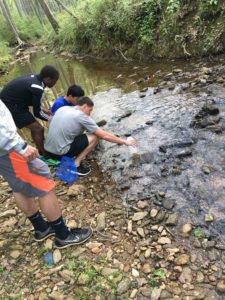Water Quality Field Trips

To view the photo-rich magazine version, click here.
Originally appears in the Fall 2017 issue
by Jessica Harwood
“You mean we’re drinking dookie water?”
Lagging behind the rest of the group during our visit to the local wastewater treatment facility, three of my student-athletes erupted into a fit of laughter. These sorts of “aha” moments are the motivation for me to take my community college students on this field trip each semester. These students had obviously sat through my lesson on biogeochemical cycles, including my bad jokes about drinking dinosaur urine, without truly comprehending the concept. However, once they saw where their flushed water goes, it suddenly all made sense.
In two field trips, I approach the topic of water quality from two directions. I want students to understand what happens to our wastewater once it leaves our drains and why this process is important. To explore these questions, we visit a wastewater treatment plant one day, and then we assess the water quality in a local stream on another day. These activities provide an excellent opportunity to review the concept of biogeochemical cycles and to introduce how water pollution can reduce dissolved oxygen levels and thereby harm wildlife. While both field trips can be adapted to students in younger grades, I’ve found that teenagers are a great fit for these experiences. In this article, I will first outline the basic parts of a standard guided wastewater treatment plant tour. Then I will suggest materials and methods for setting up an easy water quality monitoring field trip near a school.
This content is restricted to subscribers only.
If you are not yet a subscriber, please consider taking out a subscription here.
If you are an existing subscriber, kindly log in or contact us at info@greenteacher.com for more information.










